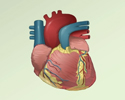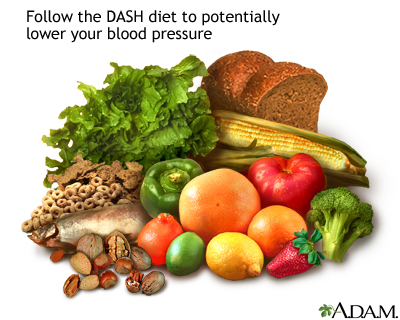Understanding the DASH diet
Hypertension - DASH diet; Blood-pressure - DASH dietThe DASH diet is low in salt and rich in fruits, vegetables, whole grains, low-fat dairy, and lean protein. DASH stands for Dietary Approaches to Stop Hypertension. The diet was first created to help lower high blood pressure. It is also a healthy way to lose weight.
Low in salt
Too much sodium in your diet can be bad for you. If you have high blood pressure or heart failure, you may be asked to limit the amount of salt (whi...

High blood pressure
Blood pressure is a measurement of the force exerted against the walls of your arteries as your heart pumps blood to your body. Hypertension is the ...

How it Works
The DASH diet helps you eat nutritious foods.
This is not just a traditional low-salt diet. The DASH diet emphasizes foods high in calcium, potassium, magnesium, and fiber, which, when combined, help lower blood pressure.
Fiber
Fiber is a substance found in plants. Dietary fiber, which is the type of fiber you can eat, is found in fruits, vegetables, and grains. It is an i...

To follow the DASH diet for weight loss, you eat plenty of:
- Non-starchy vegetables and fruit
You eat moderate portions of:
- Fat-free or low-fat dairy products
- Whole grains
- Lean meats, poultry, beans, soy foods, legumes, and eggs and egg substitutes
- Fish
- Nuts and seeds
- Heart-healthy fats, such as olive and canola oil or avocados
You should limit:
- Sweets and sugar-sweetened beverages
- Foods high in saturated fats such as full-fat dairy, fatty meals, tropical oils, and most packaged snacks
- Alcohol intake
Your health care provider can help you figure out how many calories you need to eat each day. Your calorie needs are influenced by your age, sex, activity level, medical conditions, and whether or not you are trying to lose or maintain your weight. The "A Day With the DASH Eating Plan" helps you track how many servings of each type of food you can eat. There are plans for 1,200; 1,400; 1,600; 1,800; 2,000; 2,600; and 3,100 calories per day. DASH suggests smaller portions and healthy food swaps to aid weight loss.
You can follow an eating plan that allows for either 2,300 milligrams (mg) or 1,500 mg of sodium (found in table salt and foods) per day.
Off-Limit Foods
When following the DASH plan, you should limit how much you eat of these foods:
- Foods with added salt (sodium) and adding salt to foods
- Alcohol
- Sugar-sweetened beverages
- Foods high in saturated fats, such as whole fat dairy and deep-fried foods
- Packaged snacks, which are often high in fat, salt, and sugar
Before you increase the potassium in your diet or use salt substitutes (which often contain potassium), check with your provider. People who have kidney problems or who take certain medicines must be careful about how much potassium they consume.
Potassium in your diet
Potassium is a mineral that your body needs to work properly. It is a type of electrolyte.
Read Article Now Book Mark ArticleThe Role of Exercise
DASH recommends at least 30 minutes of exercise a day, most days of the week. The important thing is to total at least 2 hours and 30 minutes per week of activities at a moderate-intensity level. Do exercises that get your heart pumping. To help prevent weight gain, exercise for 60 minutes a day.
Health Benefits
The DASH diet has been widely studied and has many health benefits. Following this diet plan may help:
- Lower high blood pressure
- Reduce the risk for heart disease, heart failure, and stroke
Heart disease
Coronary heart disease is a narrowing of the blood vessels that supply blood and oxygen to the heart. Coronary heart disease (CHD) is also called co...
 ImageRead Article Now Book Mark Article
ImageRead Article Now Book Mark ArticleHeart failure
Heart failure is a condition in which the heart is no longer able to pump oxygen-rich blood to the rest of the body efficiently. This causes symptom...
 ImageRead Article Now Book Mark Article
ImageRead Article Now Book Mark ArticleStroke
A stroke occurs when blood flow to a part of the brain stops. A stroke is sometimes called a "brain attack. " If blood flow is cut off for longer th...
 ImageRead Article Now Book Mark Article
ImageRead Article Now Book Mark Article - Help prevent or regulate type 2 diabetes
Type 2 diabetes
Type 2 diabetes is a lifelong (chronic) disease in which there is a high level of sugar (glucose) in the blood. Type 2 diabetes is the most common f...
 ImageRead Article Now Book Mark Article
ImageRead Article Now Book Mark Article - Improve cholesterol levels
- Reduce the chance of kidney stones
Kidney stones
A kidney stone is a solid mass made up of tiny crystals. One or more stones can be in the kidney or ureter at the same time.
 ImageRead Article Now Book Mark Article
ImageRead Article Now Book Mark Article
The National Heart, Blood, and Lung Institute helped develop the DASH diet. It is also recommended by:
- The American Heart Association
- U.S. guidelines for treatment of high blood pressure
Possible Health Concerns
Following this diet will provide all the nutrients you need. It is safe for both adults and children. It is low in saturated fat and high in fiber, an eating style that is recommended for everyone.
If you have a health condition, it is a good idea to talk with your provider before starting this or any diet plan to lose weight.
On the DASH diet eating plan you will likely be eating a lot more of fruits, vegetables, and whole grains. These foods are high in fiber and increasing your intake of fiber too quickly may cause GI discomfort. Slowly increase how much fiber you eat each day and be sure to drink plenty of fluids.
Ease of Use
In general, the diet is easy to follow and should leave you feeling satisfied. You will be buying more fruits and vegetables than before, which may be more expensive than prepared foods.
The diet is flexible enough to follow if you are vegetarian, vegan, or gluten-free.
Vegetarian
A vegetarian diet does not include any meat, poultry, or seafood. It is a meal plan made up of foods that come mostly from plants. These include:Ve...
Read Article Now Book Mark ArticleGluten-free
On a gluten-free diet, you do not eat wheat, rye, and barley. These foods contain gluten, a type of protein. A gluten-free diet is the main treatme...
Read Article Now Book Mark ArticleWhere to Find More Information
You can get started by going to the National Heart, Blood, and Lung Institute web page "What Is the DASH Eating Plan?" -- www.nhlbi.nih.gov/health-topics/dash-eating-plan.
You can also buy books about the DASH diet that include diet tips and recipes.
References
Bakris GL, Sorrentino MJ. Systemic hypertension: mechanisms, diagnosis, and treatment. In: Libby P, Bonow RO, Mann DL, Tomaselli GF, Bhatt DL, Solomon SD, eds. Braunwald's Heart Disease: A Textbook of Cardiovascular Medicine. 12th ed. Philadelphia, PA: Elsevier; 2022:chap 26.
Devries S. Integrative approaches to the management of patients with heart disease. In: Libby P, Bonow RO, Mann DL, Tomaselli GF, Bhatt DL, Solomon SD, eds. Braunwald's Heart Disease: A Textbook of Cardiovascular Medicine. 12th ed. Philadelphia, PA: Elsevier; 2022:chap 34.
National Heart, Lung, and Blood Institute website. DASH eating plan. www.nhlbi.nih.gov/education/dash-eating-plan. Updated December 29, 2021. Accessed September 16, 2024.
DASH diet - illustration
A diet that is effective in lowering blood pressure is called Dietary Approaches to Stop Hypertension (DASH).
DASH diet
illustration
Review Date: 9/4/2024
Reviewed By: Jacob Berman, MD, MPH, Clinical Assistant Professor of Medicine, Division of General Internal Medicine, University of Washington School of Medicine, Seattle, WA. Also reviewed by David C. Dugdale, MD, Medical Director, Brenda Conaway, Editorial Director, and the A.D.A.M. Editorial team.



